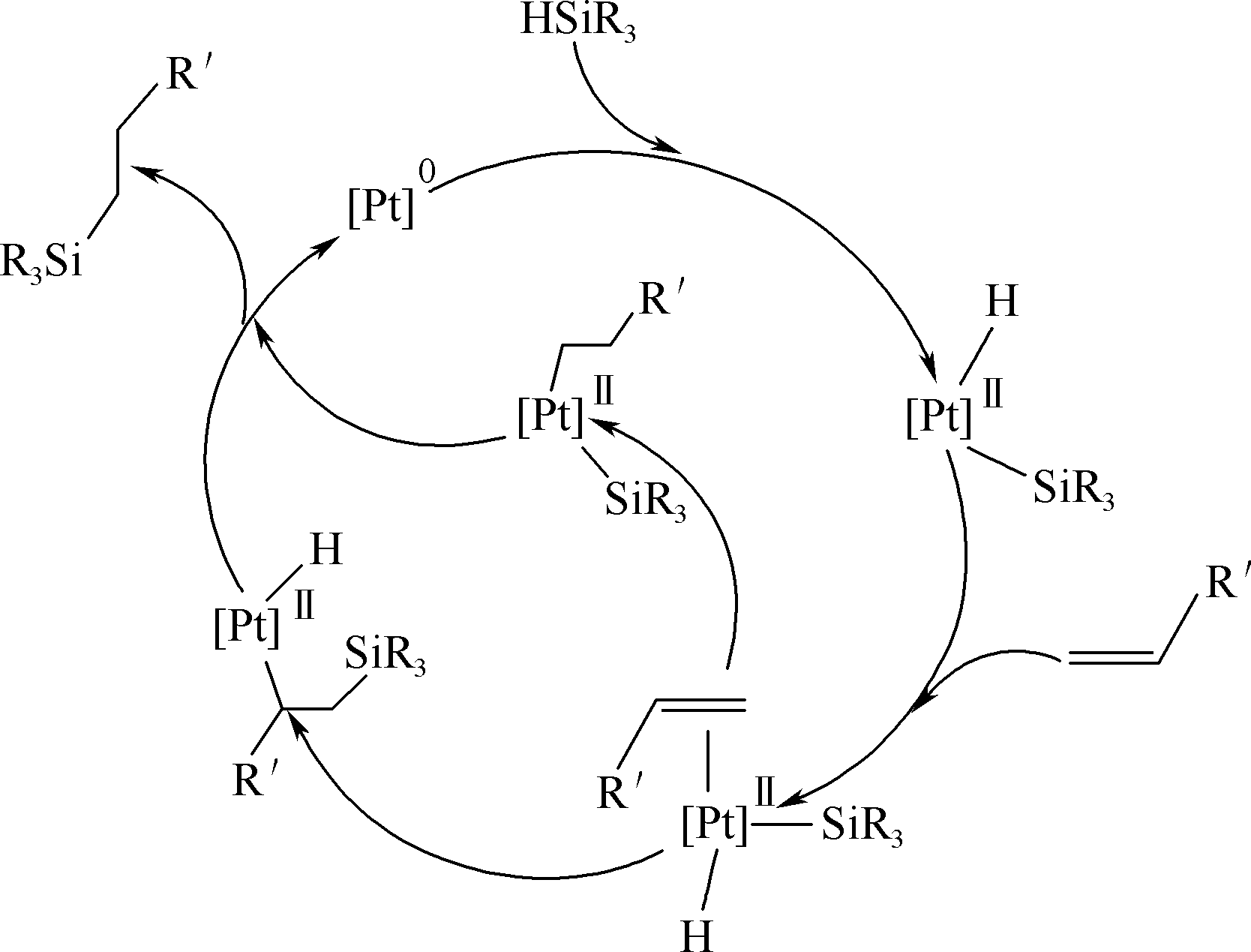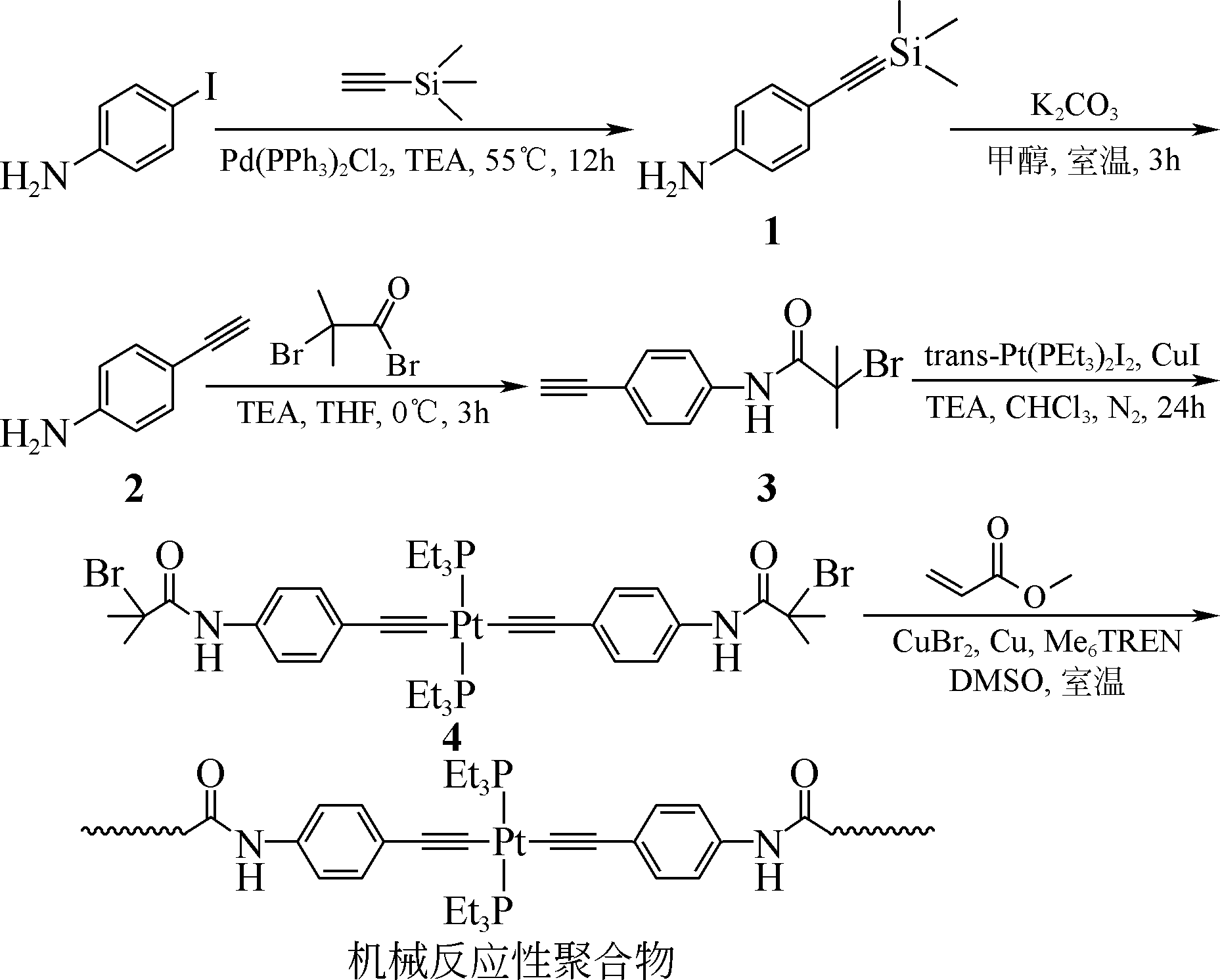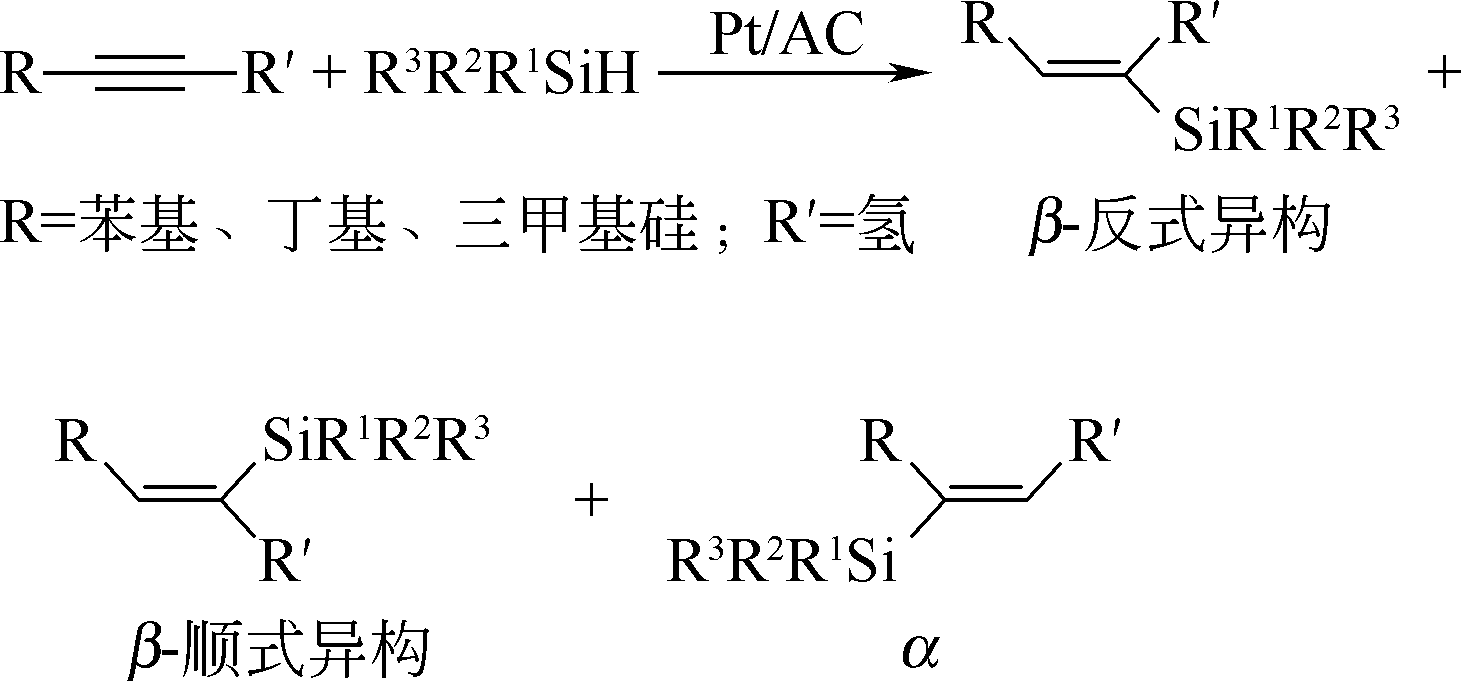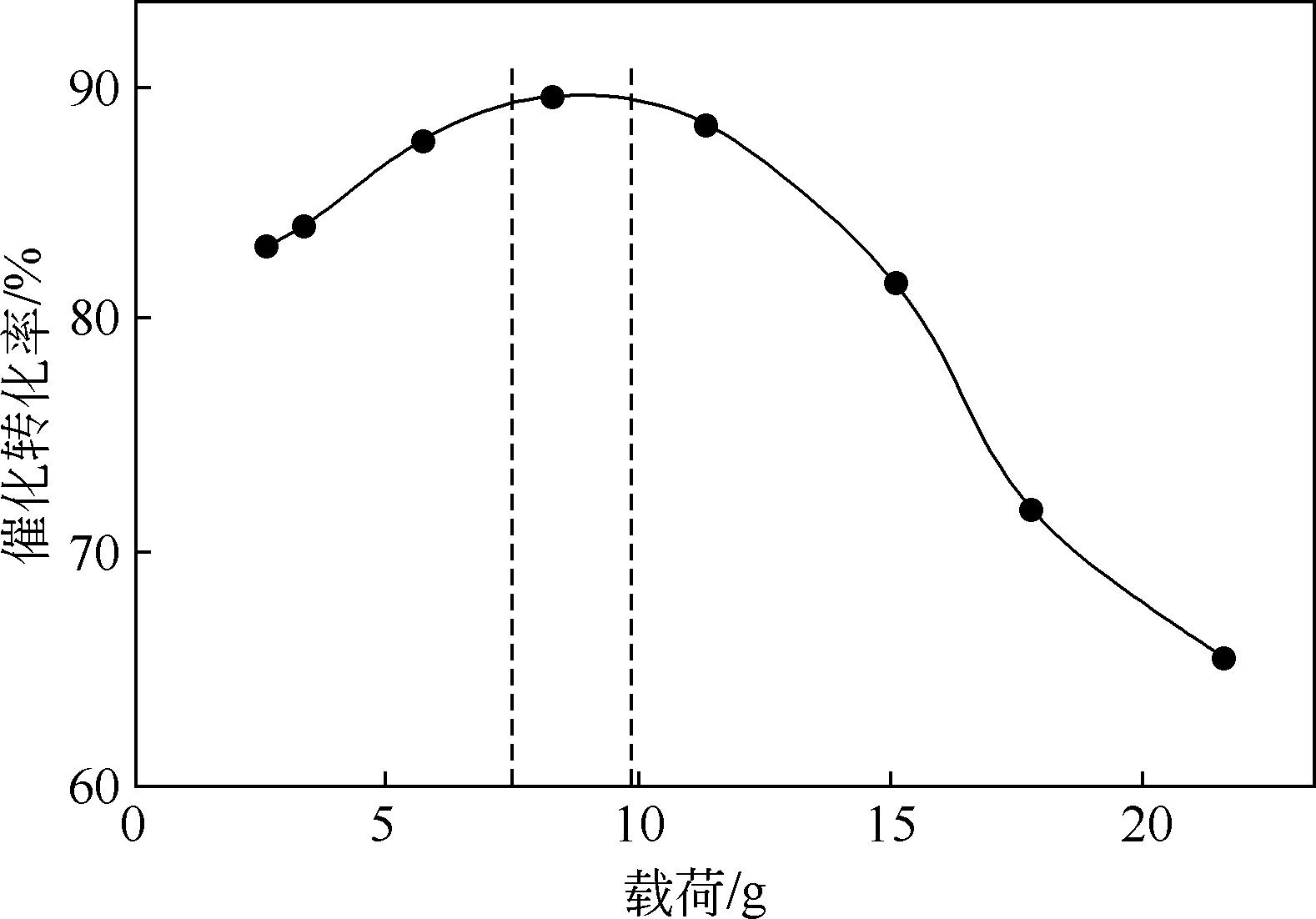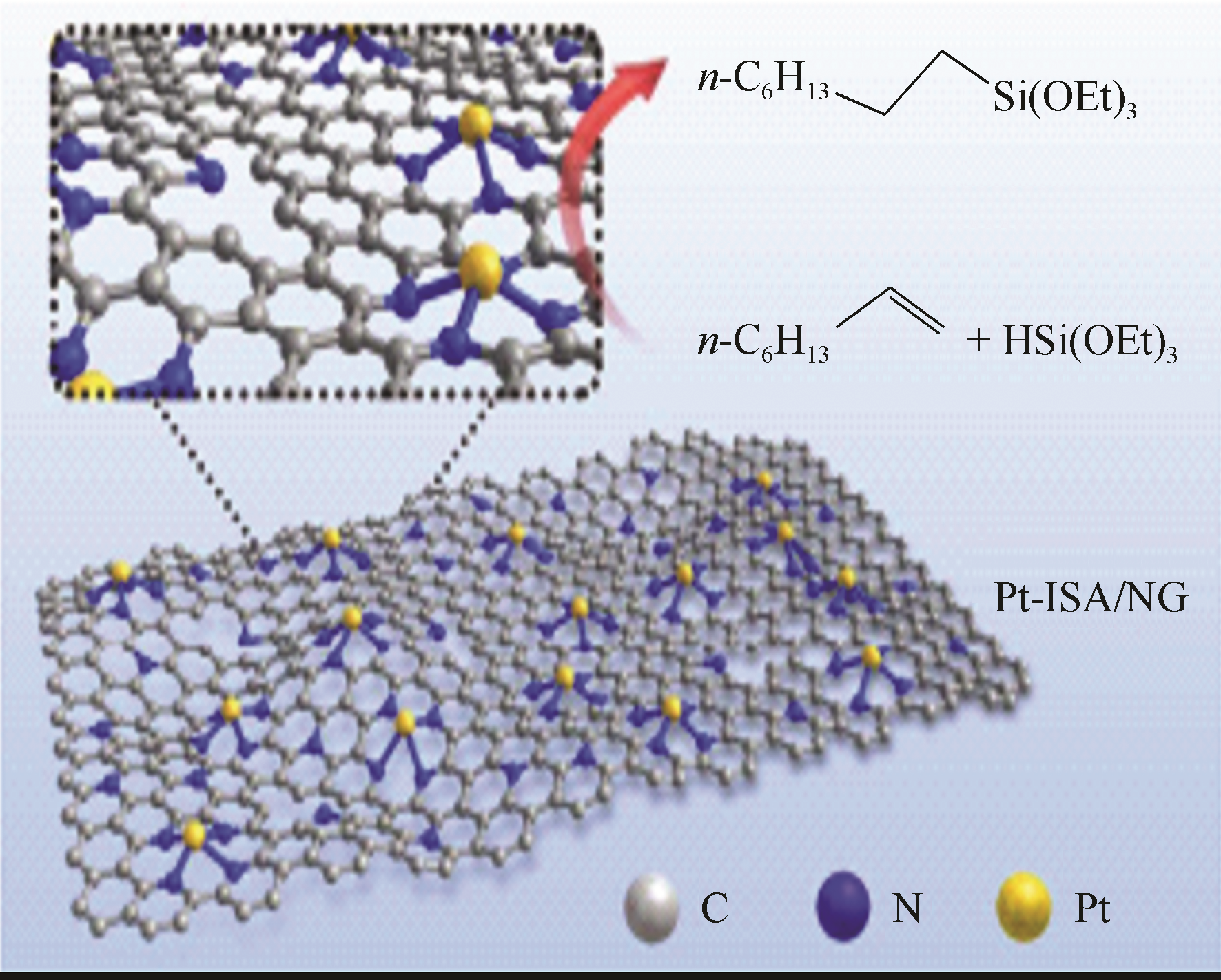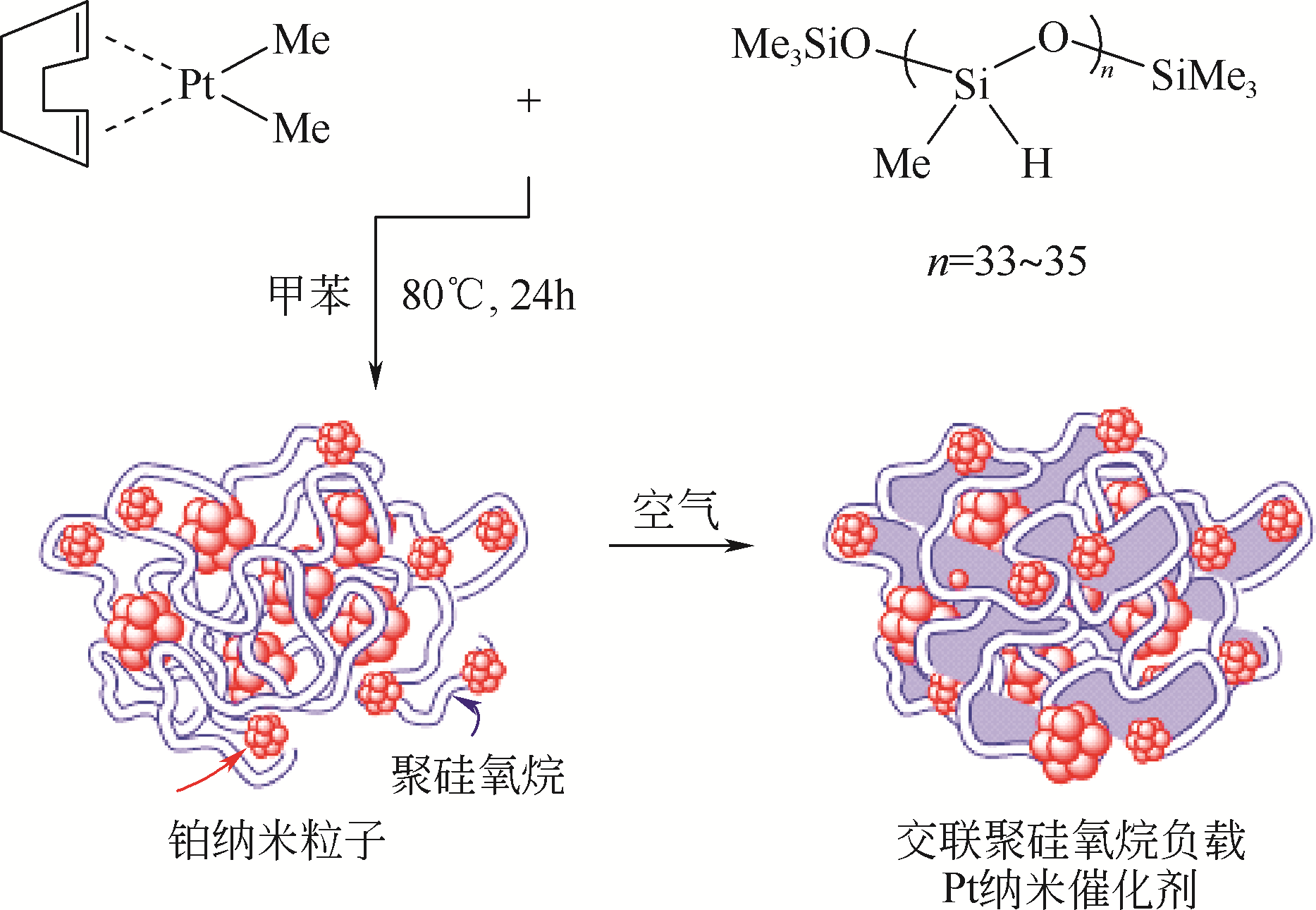Chemical Industry and Engineering Progress ›› 2020, Vol. 39 ›› Issue (3): 992-999.DOI: 10.16085/j.issn.1000-6613.2019-0958
• Industrial catalysis • Previous Articles Next Articles
Progress in platinum-catalyzed hydrosilylation reaction
Qining KE( ),Zhipeng DAI,Chen CHEN,Xuhuang CHEN(
),Zhipeng DAI,Chen CHEN,Xuhuang CHEN( )
)
- Hubei Provincial Key Laboratory of Green Materials for Light Industry, Hubei University of Technology, Wuhan 430068, Hubei, China
-
Received:2019-06-14Online:2020-04-03Published:2020-03-05 -
Contact:Xuhuang CHEN
铂催化硅氢加成反应研究进展
- 湖北工业大学绿色轻工材料湖北省重点实验室,湖北 武汉 430068
-
通讯作者:陈绪煌 -
作者简介:柯其宁(1994—),男,硕士研究生,研究方向为硅氢加成液体氟硅橡胶。E-mail:ktycoon@163.com 。 -
基金资助:绿色轻工材料湖北省重点实验室开放基金(2013CLZD04)
CLC Number:
Cite this article
Qining KE,Zhipeng DAI,Chen CHEN,Xuhuang CHEN. Progress in platinum-catalyzed hydrosilylation reaction[J]. Chemical Industry and Engineering Progress, 2020, 39(3): 992-999.
柯其宁,代志鹏,陈琛,陈绪煌. 铂催化硅氢加成反应研究进展[J]. 化工进展, 2020, 39(3): 992-999.
share this article
Add to citation manager EndNote|Ris|BibTeX
URL: https://hgjz.cip.com.cn/EN/10.16085/j.issn.1000-6613.2019-0958
| 1 | SOMMER L H,PIETRUSZA E W,WHITMORE F C.Peroxide catalyzed addition of trichlorosilane to 1-octene[J].Journal of the American Chemical Society,1947,69:188-191. |
| 2 | SPEIER J L.Homogeneous catalysis of hydrosilation by transition metals[J].Advances in Organometallic Chemistry,1979,17:407-447. |
| 3 | WAGNER G H.Reaction of silanes with aliphatic unsaturated compounds:US2637738[P].1953-05-05. |
| 4 | SPEIER J L,WEBSTER J A,BARNES G H.The addition of silicon hydrides to olefinic double bonds, part II. The use of group Ⅷ metal catalysts[J].Journal of the American Chemical Society,1957,79 (4):574-580. |
| 5 | KARSTEDT B.Platinum complexes of unsaturated siloxanes and platinum containing organopolysiloxanes:US3775452[P].1973-11-27. |
| 6 | PANDARUS V,CIRIMINNA R,GINGRAS G,et al.Waste-free and efficient hydrosilylation of olefins[J].Green Chemistry,2019,21(1):129-140. |
| 7 | WENG Z H,ZAERA F.Sub-monolayer control of mixed-oxide support composition in catalystsvia atomic layer deposition: selective hydrogenation of cinnamaldehyde promoted by (SiO2ALD)-Pt/Al2O3[J].ACS Catalysis,2018,8:8513-8524. |
| 8 | DARIUSZ B,MONIKA R,BEATA D.Regioselective formation ofβ-(E) andα-alkenylsilane moiety attached to silsesquioxane corevia Pt- and Ru-based hydrosilylation[J].Applied Organometallic Chemistry,2018,32(4):e4267. |
| 9 | CHEN Z,CHEN J,LI Y.Metal-organic-framework-based catalysts for hydrogenation reactions[J].Chinese Journal of Catalysis,2017,38(7):1108-1126. |
| 10 | CHALK A J,HARROD J F.Homogeneous catalysis Ⅱ. The mechanism of the hydrosilation of olefins catalyzed by group Ⅷ metal complexes[J].Journal of the American Chemical Society,1965,87:16-21. |
| 11 | SAKAKI S,MIZOE N,SUGIMOTO M.Theoretical study of platinum(0)-catalyzed hydrosilylation of ethylene. Chalk-Harrod mechanism or modified Chalk-Harrod mechanism[J].Organometallics,1998,17(12):2510-2523. |
| 12 | CORMA A,LEYVA A,RIVERO A M.A ligand-free Pt3 cluster catalyses the markovnikov hydrosilylation of alkynes with up to 106 turnover frequencies[J].Chemistry,2017,23(7):1702-1708. |
| 13 | ZAK P,BOLT M,PIETRASZUK C.Highly selective hydrosilylation of olefins and acetylenes by platinum(0) complexes bearing bulkyN-heterocyclic carbene ligands[J].Dalton transactions,2018,47(6):1903-1910. |
| 14 | 鲁鸿,刘金宇,李红玉,等.氮杂环卡宾与过渡金属共催化反应研究进展[J].化学学报,2018,76(11):831-837. |
| LU H,LIU J Y,LI H Y,et al.Recent developments inN-heterocyclic carbene and transition-metal cooperative catalysis[J].Acta Chimica Sinica,2018,76(11):831-837. | |
| 15 | 张凤香,白赢,杨晓玲,等.N-杂环卡宾铂配合物的合成及其在有机反应中的应用[J].化学进展,2017,29(4):412-425. |
| ZHANG F X,BAI Y,YANG X L,et al.Synthesis ofN-heterocyclic carbene platinum complexes and application in the organic reaction[J].Progress in Chemistry,2017,29(4):412-425. | |
| 16 | ZHANG F X,BAI Y,YANG X L,et al.N-heterocyclic carbene platinum complexes functionalized with a polyether chain and silyl group: synthesis and application as a catalyst for hydrosilylation[J].Phosphorus,Sulfur, andSilicon and the Related Elements,2017,192(12):1271-1278. |
| 17 | WEI K,GAO Z C,LIU H R,et al.Mechanical activation of platinum-acetylide complex for olefin hydrosilylation[J].ACS Macro Letters,2017,6(10):1146-1150. |
| 18 | 邓锋杰,徐少华,温远庆,等.4A分子筛固载铂催化剂催化乙炔硅氢加成反应[J].化工进展,2008,27(1):112-115. |
| DENG F J,XU S H,WEN Y Q,et al.4A zeolite supported platinum catalyst for hydrosilylation of acetylene[J].Chemical Industry and Engineering Progress,2008,27(1):112-115. | |
| 19 | HOFMANN R J,VLATKOVI M,WIESBROCK F.Fifty years of hydrosilylation in polymer science: a review of current trends of low-cost transition-metal and metal-free catalysts, non-thermally triggered hydrosilylation reactions, and industrial applications[J].Polymers,2017,9(10):1-37. |
| 20 | 邵冬云,李优鑫.催化硅氢加成反应负载型铂催化剂的研究进展[J].现代化工,2018,38(4):13-17. |
| SHAO D Y,LI Y X.Research progress of supported platinum catalysts for hydrosilylation[J].Modern Chemistry Industry,2018,38(4):13-17. | |
| 21 | XIE H L,YUE H B,ZHANG W X,et al.A chitosan modified Pt/SiO2 catalyst for the synthesis of 3-poly(ethylene glycol) propyl ether-heptamethyltrisiloxane applied as agricultural synergistic agent[J].Catalysis Communications,2018,104:118-122. |
| 22 | SHAO D Y,LI Y X.Preparation of polycarboxylic acid-functionalized silica supported Pt catalysts and their applications in alkene hydrosilylation[J].RSC Advances,2018,8(36):20379-20393. |
| 23 | DUKE B J,AKEROYD E N,BHATT S V.Nano-dispersed platinum(0) in organically modified silicate matrices as sustainable catalysts for a regioselective hydrosilylation of alkenes and alkynes[J].New Journal of Chemistry,2018,42(14):11782-11795. |
| 24 | LI F T,LI Y X.Preparation of efficient and environment-friendly silica-supported EDTA platinum catalyst and its applications in hydrosilylation of olefins and methyldichlorosilane[J].Journal of Molecular Catalysis A: Chemical,2016,420:254-263. |
| 25 | BAI Y,PENG J J,LI J Y,et al.Functionalized silica immobilized platinum catalyst and its application in the catalytic hydrosilylation of alkenes[J].Current Catalysis,2012,1:180-185. |
| 26 | HU W B,XIE H L,PRINSEN P,et al.Super-microporous silica-supported platinum catalyst for highly regioselective hydrosilylation[J].Catalysis Communications,2017,97:51-55. |
| 27 | DONG C,YUAN Y,CUI Y M,et al.A pronounced ligand effect on platinum-catalyzed hydrosilylation of terminal alkynes[J].Applied Organometallic Chemistry,2018,32(2) :e4037. |
| 28 | DOROKHOV V G,DOROKHOVA G F,SAVCHENKO V I.Study of the products of platinum-catalyzed hydrogenation of chlorinatednitro and amino aromatic compounds at high degree of dehalogenation[J].Russian Chemical Bulletin,2018,67(8):1412-1418. |
| 29 | 刘玉荣.碳材料在超级电容器中的应用[M].北京:国防工业出版社,2013:211-237. |
| LIU Y R.Carbon materials for supercapacitor application[M].Beijing:National Defence Industry Press,2013:211-237. | |
| 30 | ZHANG P,SUN D R,CHO A,et al.Modified carbon nitride nanozyme as bifunctional glucose oxidase-peroxidase for metal-free bioinspired cascade photocatalysis[J].Nature Communications,2019,10(1):940-953. |
| 31 | DONGIL A B,BACHILLER-BAEZA B,GUERRERO-RUIZ A,et al.Graphite oxide as support for the immobilization of Ru-BINAP: application in the enantioselective hydrogenation of methylacetoacetate[J].Catalysis Communications,2012,26:149-154. |
| 32 | ZHAO Y F,ZHANG H Y,HUANG C L,et al.Pd nanoparticles immobilized on graphite oxide modified with a base: highly efficient catalysts for selective hydrogenation of citral[J].China Chemistry,2013,56(2):203-209. |
| 33 | RAO F Y,DENG S J,CHEN C,et al.Graphite oxide-supported Karstedt catalyst for the hydrosilylation of olefins with triethoxysilane[J].Catalysis Communications,2014,46:1-5. |
| 34 | KONG C J,GILLILAND III S E,CLARK B R,et al.Highly-active, graphene-supported platinum catalyst for the solventless hydrosilylation of olefins[J].Chemical Communications,2018,54(95):13343-13346. |
| 35 | ZHU Y Q,CAO T,CAO C B,et al.A general synthetic strategy to monolayer graphene[J].Nano Research,2018,11(6):3088-3095. |
| 36 | ZHU Y Q,CAO T,CAO C B,et al.One-pot pyrolysis to N-doped graphene with high-density Pt single atomic sites as heterogeneous catalyst for alkene hydrosilylation[J].ACS Catalysis,2018,8(11):10004-10011. |
| 37 | CIRIMINNA R,PANDARUS V,GINGRAS G,et al.Closing the organosilicon synthetic cycle: efficient heterogeneous hydrosilylation of alkenes over siliacat Pt (0)[J].ACS Sustainable Chem. Eng.,2013,1(2):249-253. |
| 38 | CUI X,JUNGE K,DAI X,et al.Synthesis of single atom based heterogeneous platinum catalysts: high selectivity and activity for hydrosilylation reactions[J].ACS Central Science,2017,3(6):580-585. |
| 39 | TSUCHIDO Y,ABE R,KAMONO M,et al.Hydrosilylation of aromatic aldehydes and ketones catalyzed by mono- and tri-nuclear platinum(0) complexes[J].Bulletin of the Chemical Society of Japan,2018,91(5):858-864. |
| 40 | JENNIFER V O,PAUL J C.Earth-abundant transition metal catalysts for alkene hydrosilylation and hydroboration: opportunities and assessments[J].Nature Reviews: Chemistry,2018,2(5):15-34. |
| 41 | LU K,HU Z,XIANG Z,et al.Cation intercalation in manganese oxide nanosheets: effects on lithium and sodium storage[J].Angewandte Chemie,2016,55(35):10448-10452. |
| 42 | CHEN Y J,JI S F,SUN W M,et al.Discovering partially charged single-atom Pt for enhanced antimarkovnikov alkene hydrosilylation[J].Journal of the American Chemical Society,2018,140(24):7407-7410. |
| 43 | MICHALSKA Z M,STRZELEC K,SOBCZAK J W.Hydrosilylation of phenylacetylene catalyzed by metal complex catalysts supported on polyamides containing a pyridine moiety[J].Journal of Molecular Catalysis A: Chemical,2000,156(1):91-102. |
| 44 | CHAUHAN B P S,SARKAR A.Functionalized vinylsilanesviahighly efficient and recyclable Pt-nanoparticle catalysed hydrosilylation of alkynes[J].Dalton Transactions,2017,46(27):8709-8715. |
| 45 | 谢志凯,陈秀莹,胡文斌,等.功能化金属有机骨架负载铂高效催化硅氢加成反应[J].分子催化,2018,32(6):520-529. |
| XIE Z K,CHEN X Y,HU W B,et al.Functionalized metal-organic framework supported platinum highly efficient catalytic hydrosilylation[J].Journal of Molecular Catalysis,2018,32(6):520-529. | |
| 46 | QIAO Y,MA W,THEYSSEN N,et al.Temperature-responsive ionic liquids: fundamental behaviors and catalytic applications[J].Chemical Reviews,2017,117(10):6881-6928. |
| 47 | WELTON T.Ionic liquids: a brief history[J].Biophysical Reviews,2018,10(3):691-706. |
| 48 | MAGDALENA J W,IZABELA D,RYSZARD F,et al.The effect of the morpholinium ionic liquid anion on the catalytic activity of Rh (or Pt) complex-ionic liquid systems in hydrosilylation processes[J].RSC Advances,2018,8(47):26922-26927. |
| 49 | FERNÁNDEZ G,PLEIXATS R.Soluble Pt nanoparticles stabilized by atris-imidazolium tetrafluoroborate as efficient and recyclable catalyst for the stereoselective hydrosilylation of alkynes[J].Chemistry Select,2018,3(41):11486-11493. |
| 50 | 刘国旺.含氢硅烷的硅氢加成反应及其催化剂负载化研究[D].杭州:浙江大学,2010. |
| LIU G W.Hydrosilylation of hydrosilanes and the synthesis of Pt catalyst supported on HNTs[D].Hangzhou:Zhejiang University,2010. | |
| 51 | 陈伟,闫婉婉,胡庆华.SBA-15微球负载Karstedt催化剂制备及对硅氢加成反应动力学[J].硅酸盐学报,2016,44(3):419-424. |
| CHEN W,YAN W W,HU Q H.Preparation of SBA-15 supported Karstedt catalysts and catalytic kinetics on hydrosilylation[J].Journal of the Chinese Ceramic Society,2016,44(3):419-424. | |
| 52 | ROSSI L M,COSTA N J S,SILVA F P,et al.Magnetic nanomaterials in catalysis: advanced catalysts for magnetic separation and beyond[J].Green Chemistry,2014,16(6):2906-2933. |
| 53 | ZAI H C,ZHAO Y Z,CHEN S Y.A novel hierachically-nanostructured Pt/SiO2/Fe3O4 catalyst with high activity and recyclability towards hydrosilylation[J].RSC Advance,2016,6(100):98520-98527. |
| [1] | ZHANG Mingyan, LIU Yan, ZHANG Xueting, LIU Yake, LI Congju, ZHANG Xiuling. Research progress of non-noble metal bifunctional catalysts in zinc-air batteries [J]. Chemical Industry and Engineering Progress, 2023, 42(S1): 276-286. |
| [2] | SHI Yongxing, LIN Gang, SUN Xiaohang, JIANG Weigeng, QIAO Dawei, YAN Binhang. Research progress on active sites in Cu-based catalysts for CO2 hydrogenation to methanol [J]. Chemical Industry and Engineering Progress, 2023, 42(S1): 287-298. |
| [3] | XIE Luyao, CHEN Songzhe, WANG Laijun, ZHANG Ping. Platinum-based catalysts for SO2 depolarized electrolysis [J]. Chemical Industry and Engineering Progress, 2023, 42(S1): 299-309. |
| [4] | YANG Xiazhen, PENG Yifan, LIU Huazhang, HUO Chao. Regulation of active phase of fused iron catalyst and its catalytic performance of Fischer-Tropsch synthesis [J]. Chemical Industry and Engineering Progress, 2023, 42(S1): 310-318. |
| [5] | WANG Lele, YANG Wanrong, YAO Yan, LIU Tao, HE Chuan, LIU Xiao, SU Sheng, KONG Fanhai, ZHU Canghai, XIANG Jun. Influence of spent SCR catalyst blending on the characteristics and deNO x performance for new SCR catalyst [J]. Chemical Industry and Engineering Progress, 2023, 42(S1): 489-497. |
| [6] | DENG Liping, SHI Haoyu, LIU Xiaolong, CHEN Yaoji, YAN Jingying. Non-noble metal modified vanadium titanium-based catalyst for NH3-SCR denitrification simultaneous control VOCs [J]. Chemical Industry and Engineering Progress, 2023, 42(S1): 542-548. |
| [7] | CHENG Tao, CUI Ruili, SONG Junnan, ZHANG Tianqi, ZHANG Yunhe, LIANG Shijie, PU Shi. Analysis of impurity deposition and pressure drop increase mechanisms in residue hydrotreating unit [J]. Chemical Industry and Engineering Progress, 2023, 42(9): 4616-4627. |
| [8] | WANG Peng, SHI Huibing, ZHAO Deming, FENG Baolin, CHEN Qian, YANG Da. Recent advances on transition metal catalyzed carbonylation of chlorinated compounds [J]. Chemical Industry and Engineering Progress, 2023, 42(9): 4649-4666. |
| [9] | ZHANG Qi, ZHAO Hong, RONG Junfeng. Research progress of anti-toxicity electrocatalysts for oxygen reduction reaction in PEMFC [J]. Chemical Industry and Engineering Progress, 2023, 42(9): 4677-4691. |
| [10] | GE Quanqian, XU Mai, LIANG Xian, WANG Fengwu. Research progress on the application of MOFs in photoelectrocatalysis [J]. Chemical Industry and Engineering Progress, 2023, 42(9): 4692-4705. |
| [11] | WANG Weitao, BAO Tingyu, JIANG Xulu, HE Zhenhong, WANG Kuan, YANG Yang, LIU Zhaotie. Oxidation of benzene to phenol over aldehyde-ketone resin based metal-free catalyst [J]. Chemical Industry and Engineering Progress, 2023, 42(9): 4706-4715. |
| [12] | GE Yafen, SUN Yu, XIAO Peng, LIU Qi, LIU Bo, SUN Chengying, GONG Yanjun. Research progress of zeolite for VOCs removal [J]. Chemical Industry and Engineering Progress, 2023, 42(9): 4716-4730. |
| [13] | ZHU Chuanqiang, RU Jinbo, SUN Tingting, XIE Xingwang, LI Changming, GAO Shiqiu. Characteristics of selective non-catalytic reduction of NO x with solid polymer denitration agent [J]. Chemical Industry and Engineering Progress, 2023, 42(9): 4939-4946. |
| [14] | MAO Shanjun, WANG Zhe, WANG Yong. Group recognition hydrogenation: From concept to application [J]. Chemical Industry and Engineering Progress, 2023, 42(8): 3917-3922. |
| [15] | WANG Baoying, WANG Huangying, YAN Junying, WANG Yaoming, XU Tongwen. Research progress of polymer inclusion membrane in metal separation and recovery [J]. Chemical Industry and Engineering Progress, 2023, 42(8): 3990-4004. |
| Viewed | ||||||
|
Full text |
|
|||||
|
Abstract |
|
|||||

